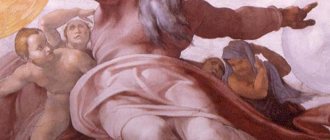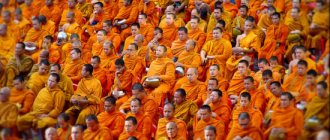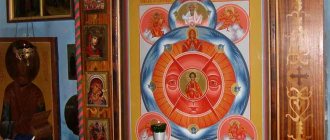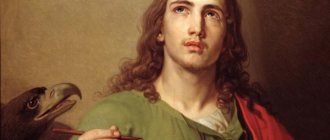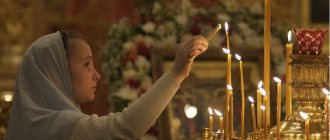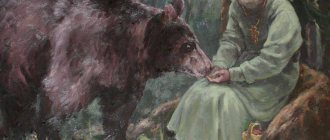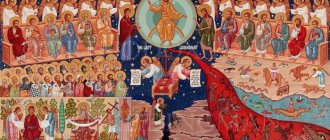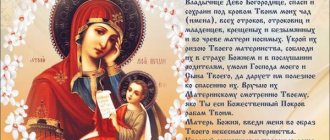Buddhist gods are recognized by supporters of this religion as beings of a separate class that are subject to the laws of karma. It is noteworthy that at the same time, this religion categorically denies the existence of a supreme creator-ruler who would create this world and rule it. Anyone who finds themselves in a Buddhist temple is simply amazed at the number of images of all kinds of deities. Surprisingly, their total number remains unknown. At least there are more than three thousand of them, and catalogs with their images occupy several volumes.
Essence
For adherents of this faith, Buddhist gods are a reflection of their own mind, which corresponds to various aspects of their thinking and perception of the outside world. In reality, they do not have any specific form, existing independently of each other.
Moreover, behind each image of a Buddhist god there is symbolism developed to the smallest detail. Every detail is endowed with meaning - color, shape of deities, hand gestures, posture, available attributes and decorations.
Interestingly, there is simply no generally accepted classification of the pantheon of Buddhist gods. Moreover, most images are conditionally divided into three Buddha Bodies.
Links
- About the peacefulness of Buddhists.
- About relationships within Zen monasteries
- Bodhisattvas and pron
- Introduction to Buddhology from Professor Torchinov - a canonical, scientific, detailed introduction to this Buddhism of yours without pop, atsral and SMS. It reveals the background, teaches you to distinguish between schools, explains terms and will not let you confuse Zen with yoga, IRL karma with Habré karma, and Tibetan Buddhism with Thai. Posers and enlighteners don’t have a chance to master it, because they have to think.
| [ + ] “Buddha Gautama is the opium of the people!” | |||||||||||||||||
| |||||||||||||||||
| [ + ] Buddha Gautama is a feature of Zhongguo. | |||||||||
| |||||||||
Features of Buddhism
One of the peculiarities of this religion is the fact that the concept of God, in our usual sense, does not exist here. That's why Buddhists generally don't pray—they don't have an omnipotent figure to ask for things from, like most other religions. Many remind that even the Buddha himself emphasized this and taught him not to worship or deify him.
There is mention of this in ancient texts that date back to approximately the first century AD. The entire essence of this religion is contained in these Buddhist scrolls. God, i.e. I - these concepts are largely identified. Man himself is compared to the seed and core of all things, as well as the cause, the basis and the trunk. Buddhists believe that the ramifications of any incident or event arise from a specific individual.
Also
| « | The religion of the future will be a cosmic religion. She will have to overcome the idea of God as a person, and also avoid dogma and theology. Embracing both nature and spirit, it will be based on a religious feeling arising from the experience of the meaningful unity of all things - both natural and spiritual. Buddhism fits this description. If there is a religion that can meet modern scientific needs, it is Buddhism. | » |
| - Albert Einstein | ||
Yes, the Buddha personally said in the Lokhovada Sutta that anyone who will force the words of Einstein supposedly about Buddhism as the best religion will be reborn as Turritopsis Nutricula!
Namsaray
A common symbol in this religion is the Buddhist god of wealth - Namsaray. He is traditionally depicted riding a snow-white lion. He has a yellow-gold body and an angry expression on his face. In his right hand he holds a victory banner, and in his left - a mongoose, which is associated with wealth and prosperity.
He is often depicted on the outer walls of temples and monasteries as a protector against negative forces. It is believed that this Buddhist god is one of the most popular among believers.
What is the practice
Followers of Buddhism strive for liberation from the clouding of the mind that distorts true reality. They try to get rid of negative qualities:
- anger,
- bitterness,
- anxiety,
- horror,
- lack of education,
- lack of culture,
- pride,
- egocentrism,
- laziness,
- mistrust,
- envy,
- greed,
- discontent.
The virtue of the doctrine is the cultivation of pure and sublime qualities in its adherents:
- humanity,
- generosity,
- gratitude,
- mercy,
- sympathy,
- diligence,
- prudence.
These properties contribute to the gradual mastery of truth and purification of the mind, resulting in a stable sense of well-being. By working on their mind, strengthening, ennobling and making it brighter, Buddhists relieve anxiety, irritation and dissatisfaction, which ultimately lead to trouble, despondency and depression. This is why Buddhism becomes an indispensable condition for enlightenment and the irrevocable release of consciousness. Buddhism is considered a religion of a worldview, not a supernatural one.
God symbols
The symbols with which Namsaray is depicted are of great importance, just like any other Buddhist deity.
Namsaray is usually accompanied by:
- Two goldfish, which symbolize liberation from samsara;
- A white shell (with its spiral turned to the right side, symbolizing the sound of Buddha’s enlightenment).
- A precious vase from which rains down a long and healthy life, prosperity and health.
- The lotus flower is a symbol of spiritual purity and an impeccable body.
- A golden wheel with eight spokes, which symbolize the eightfold path of any Buddhist. It consists of right thinking, vision, action, right speech, paths to livelihood, effort, mental training and concentration.
- The victory banner installed on the top of the sacred Mount Meru, located at the center of the Universe.
- The umbrella is a symbol of the king's power, protecting against evil influence, which is bestowed on all compassionate Buddhas.
- The Eternal Knot (or Luck Knot), one of its meanings is the complex relationship between compassion and wisdom, as well as harmony and endless love.
Symbols in Buddhism are of great importance, which is why it is so important to know and understand them.
Worldwide distribution
The appeal to independence from grief and belief in the activity of the cosmos led to the emergence in the West in the last and century before last of new theories of mentality and worldview based on the concept of Buddhism. Initially, the followers of Buddhist philosophy were immigrants from Asian and Eastern powers, depressed by hidden anxieties. Later, they were joined by an unbelieving population of various persuasions.
Buddhism was considered the official faith in Tibet until China occupied the country in the 1950s. The Dalai Lama, the head of the Buddhists, was also the state leader of the region. As a result of the intervention of the Celestial Empire, he had to emigrate. Having settled in India, he continued to lead his followers from there.
Overseas and in European countries, the teaching became very popular in the form of Zen Buddhism. This trend came from Japan, where it was formed in the 12th century. This movement received recognition after a striking speech by its follower, a Japanese monk, during the Chicago Religious Congress. Since then, Zen Buddhism, along with yoga, has become the most widespread Orientalist theory in the West, which emphasizes the regulation of the mind over the body.
In Zen practices there is no authority of divine texts, prayers and instructions, but increased interest is paid to personal meditation. As in traditional Buddhism, in Zen the mind is known through practice, the highest manifestation of knowledge being enlightenment. The increased attention to Zen Buddhism is explained by the unpretentiousness of this teaching.
Kurukulla
Kurukulla is the Buddhist goddess of love. She is considered one of the incarnations of Red Tara, one of the main bodhisattvas of this religion.
It is believed that Kurukulla is the patron of love, magic, witchcraft and healing (her analogues in other religions are Rati in Hinduism, and she also has many similarities with Kali).
Her main attribute is an arrow and a bow made of flowers. In traditional iconography, the goddess's body is depicted in red, she wears a crown made up of human skulls, and her hair is always spread upward. A tiger skin is draped around the waist, and a garland of severed human heads hangs from the shoulders. Kurukulla is four-armed.
Buddhism describes four of its activities. White - able to pacify, calm and heal. Yellow - promotes increased wealth, abundance, prosperity and wisdom. Red - capable of subjugating people to her power, bewitching and enchanting them. Black - interferes with the spiritual path, destroys evil, promotes angry manifestations.
In some areas where Buddhism is widespread, Kurukulla is considered the main patroness of sex and love. This is what makes the Buddhist goddess stand out from other so-called creatures (the article contains only some of their names and photos). This status also makes her similar to the Greek Aphrodite. In this case, the images with the patroness of love are quite frank - she is depicted as a naked 16-year-old girl, seductive and sensual. This deity is especially revered by Tibetans. In particular, for her magical abilities to bewitch people, gaining power over them.
Dharmapalas - defenders of the teachings
The defenders of dharma, or Dharmapalas, are distinguished into a separate and numerous class. They usually take on wrathful forms to protect the dharma and its adherents. Some of them became Dharmapalas voluntarily, some were obliged by Padmasambhava.
This also includes various local spirits. They can be local: for example, in Russia, in particular in Kalmykia, Buryatia, Tuva, the protector Prana Atma is known, which in Tibetan is called “Begtse Chamsin” and patronizes warriors and armed people.
Dharmapalas typically have red hair, a fiery glow, and a crown of five skulls. This species is considered the most numerous, so let’s briefly look at the main ones:
- Mahakala - similar to Shiva, he is the evil form of Avalokiteshvara and has a dark blue hue, maybe with 2, 4 or 6 arms.
- Vajrabhairava is a terrible form of Manjugosha.
- Palden Lhamo - a female dharmapala, a terrible hypostasis of Saraswati, who is close to Kali, is depicted in dark blue.
- Vajrakilaya, the main wrathful deity of the Nyingma school, removes obstacles.
- Yamantaka is the conqueror of the bull-faced god of death Yama, the wrathful form of Manjushri. One of his images is with sixteen legs, thirty-two palms and nine heads, one of them being a bull.
- Hayagriva is a creature with three heads, six arms, four legs, and sometimes with wings, the incarnation of Amitabha, holding a club or trident in his hands.
- Rahula - has the body of a snake, a huge number of mouths and nine faces with which he swallows nine planets.
Dharmapala Rahula
- Ekajati is the wrathful form of Tara, she has one tooth, a single breast and a small tuft of hair on her head. Instead of a loincloth there is tiger fur, and on the neck there is a necklace of human heads.
Manjushri
In the list of Buddhist gods, such a symbol as Manjushri finds its place, which cannot be ignored. This is one of the oldest Buddhist images; it is called the closest associate and comrade-in-arms of Gautama Buddha.
The first mentions of it are found in the earliest Mahayana texts, that is, in sources dating back to BC. It is believed that he personifies will, reason and wisdom. His cult is especially popular in Tibet and China.
Essentially, Manjushri is a teacher and guide, considered one of the few who possess the highest degree of wisdom. It is for this reason that prayers addressed to him help achieve true enlightenment. Those who worship him have well-developed intuition, as well as clairvoyance and all sorts of other mystical abilities.
In Tibet and China, mention of Manjushri can be found in various legends and sources. The Chinese Emperor Nurhaci, the founder of the Manchu Empire, who ruled at the turn of the 16th-17th centuries, considered himself one of the incarnations of this deity.
Quotes
Most of them are set out in the Diamond Sutra. For example:
| - You can’t trust anyone! - And you? - Can i. |
Or a parable...
...about trolling:
| Gautama Buddha passed by a village where opponents of Buddhists lived. Residents jumped out of their houses, surrounded him and began to insult him. The Buddha's disciples began to get angry and were ready to fight back, but the presence of the Teacher had a calming effect. And what he said confused both the villagers and the students. He turned to the students and said: “You disappointed me.” These people are doing their job. They are angry. It seems to them that I am an enemy of their religion, their moral values. These people insult me, it's natural. But why are you angry? Why do you have this reaction? You allowed these people to manipulate you. You depend on them. Aren't you free? The people from the village did not expect such a reaction. They were puzzled. In the ensuing silence, Buddha turned to them: “Have you said everything?” If you haven’t said everything, you will still have the opportunity to tell me everything you think when we return. The people from the village said: “But we insulted you, why aren’t you angry with us?” Buddha replied: “You are free people, and what you did is your right.” I don't react to this. I am also a free person. Nothing can make me react and no one can influence or manipulate me. My actions flow from my inner state. And I would like to ask you a question that concerns you. In the previous village, people met me, greeted me, they brought flowers, fruits, and sweets. I told them: “Thank you, we have already had breakfast. Take these fruits and sweets with my blessing for yourself. We can’t carry them with us, we don’t carry food with us.” And now I ask you: - What should they do with what I did not accept and returned to them? One person from the crowd said: “They must have distributed fruits and sweets to their children, to their families.” - What will you do with your insults and curses? I do not accept them and return them to you. If I can reject those fruits and sweets, they should take them back. What can you do? I reject your insults, so you too take your load home and do with it whatever you want. And now my students will fuck you. |
...about the tigress:
| According to legend, Buddha in his previous incarnation met a hungry tigress with five cubs in Nepal. The tigress was ready to devour her cubs. Seeing all this, the Buddha was filled with such compassion that he jumped off the cliff to feed the tigress with his body. In his next life, he was reborn in Lumbini as the well-known prince Siddhartha, and five tiger cubs were reborn as humans and became the first disciples of the Buddha. |
| Moral: Inadequacy is rewarded. Become An Hero. |
...about the yogi:
| One day, the Buddha, traveling with some of his followers, met an exhausted yogi in the wilderness, living alone among the forests in a hut. The teacher stopped and asked how long the anchorite had been laboring in this place. “Twenty-five years,” answered the yogi. —What have you achieved through such self-torture? - Buddha asked again. “I can cross the river directly on the water,” the hermit proudly declared. “Oh, poor fellow,” the sage remarked with pity, “have you really spent so much time on this?” After all, the ferryman would only charge you one obol for the crossing. |
Buddha Shakyamuni
Among the names of Buddhist gods you will definitely come across Buddha Shakyamuni. It is believed that this is the same Gautama known to most of us. It was he who became the first person, according to his fans, to achieve enlightenment. But for this he had to overcome several hundred lives in the wheel of Samsara. Only after this did he manage to get out and break this cycle of rebirths.
Buddha is a wise and strong ruler; it is believed that, first of all, he is the patron of scientists, philosophers, people of creative and intellectual professions. He helps all of them find their path to true enlightenment.
Sources
- A brief comparison of the five Tibetan traditions (Buddhist and Bon). Alexander Berzin. Berlin, January 10, 2000. Supplemented with excerpts from a lecture on the same topic given in Munich on January 30, 1995.
- Tulku Urgyen Rinpoche. Repeating the words of Buddha. Translation from English by S. Selivanov, B. Grebenshchikov, St. Petersburg, Yasny Svet Publishing House, 1997
- Sogyal Rinpoche. Lerab Ling, June 1997.
- “Space and bliss. Buddhist statues and ritual objects." Translation by Yulia Vorotnikova. Russian Association of Diamond Way Buddhists of the Karma Kagyu Tradition, 2011
- Defenders of Dharma. Lama Ole Nydahl
- Androsov V.P. Indo-Tibetan Buddhism: Encyclopedic Dictionary. M., 2011.
- Karma Agwan Yondan Zhamtso. A beacon of confidence. St. Petersburg, 1993
Share link:
Medicine Buddha
The list of Buddhist gods includes the Medicine Buddha. Interestingly, he appears in seven guises at once. It is believed that if you use it regularly, it will help get rid of most existing diseases. And not only physically, but also spiritually.
The Medicine Buddha gives vitality and powerful energy to his wards, whom he protects, helping them achieve success in healing and other areas.
Especially for him there is a special Mantra of Medicine, which true believers Buddhists pronounce exactly 108 times daily.
Traditionally he is depicted in the lotus position and wearing monastic robes. In his left hand he has a begging bowl in which medicinal plants grow, and in his right hand there is a stem of myroblan. At the same time, he sits on a lotus flower or a lion throne.
Among the attributes and symbols of the Medicine Buddha one can often find boxes of medicines, as well as a clay jug.
Fundamental views
After observing his mind for several years, the Buddha concluded that the source of human torment and sorrow is people themselves: their passion for life, property and finances, their belief in the inviolability and eternity of the soul. This was an experiment in creating a delusion to counteract global changeability. The end of torment (entry into nirvana) and awakening, in which life appears truthful and natural, can be achieved by destroying all attachments and delusions of stability, which is facilitated by the experience of concentration and limitation, observance of the five precepts.
Buddha stated that his theory is not a sacred prophecy, but was acquired by him as a result of meditation and observation of his own soul and other things. The position has not become dogmatic, accepted on faith without criticism, and the effect depends on the follower himself. The Buddha instructed to accept his teachings only through testing on one's own experience, comparing this process with the procedure for a merchant to check the authenticity of gold when buying. He advised accepting his theory only after being convinced of its reliability.
Over the 25 centuries of its existence, Buddhist philosophy has absorbed a lot of different spiritual practices and rituals. Some supporters of Buddhism consider reflection based on meditation to be the main thing, others prefer to engage in useful activities, and still others focus on honoring the Buddha. The dissimilarity in the concepts and ideas of different Buddhist schools obliges us to accept as Buddhism any teaching that traditionally becomes Buddhist and is based on the principles that the Buddha himself established. But the interpretation of concepts in different theories is sometimes strikingly different. Theravada supporters assert the finality of the doctrines, while Mahayana adherents insist on their conditionality; they consider them a transitional stage in the comprehension of the teachings. The same for different teachings is:
- biography of Shakyamuni;
- acceptance of retribution and transformation (samsara);
- 4 sublime truths and the eightfold path;
- dependent emergence theory.
The interpretation of these components in different schools is also ambiguous. Some Mahayana documents describe these elements only as skillful tools to attract the attention of people with ordinary spiritual potential to Buddhism.
Vajrapani
The image of the Buddhist god Vajrapani can often be found in the iconography of this religion. He is considered one of the three protectors of Gautama, symbolizing the power of the true teaching. He personifies both angry and benign traits, for this reason he can patronize even the most ordinary people who are fighting among themselves for the light and dark principles.
It is worth noting that this is an extremely decisive deity who has the ability to endow other people with this same trait. It is also believed that it can push a person to perform good deeds and deeds. Therefore, those who are born under his protection often turn to him for help in extremely difficult situations.
In the very first images in iconography, Vajrapani is associated with the god of thunder. When the influence of Greek culture began to spread in Central Asia, which led to the emergence of Greco-Buddhism, it began to be personified with Hercules.
As a rule, God is depicted as a muscular and majestic athlete who holds a diamond club in his hands.
Three Sources of Refuge
Lama
,
Yidams
and
Protectors
are the so-called 3 roots (sources) of Buddhist Refuge.
In general, the main Vajrayana practices can be reduced to 3 classes:
- Meditation on Lama
(Guru) for blessing, inspiration.
- Meditations on the Protectors
to achieve enlightened activity. Protectors are able to destroy obstacles on the spiritual path, fight external and internal demons, and also help to keep vows and control internal desires.
- Meditations on the Yidams
for special abilities (siddhi).
Vajrasattva
This deity is also called Samantabhadra Buddha or the Enlightened One. It is a symbol of transcendental wisdom that exists beyond the understanding of ordinary man.
It is believed that turning to him for protection can bring purification to the requester, drive away dark thoughts and even clear karma. It is worth emphasizing that this particular deity has special significance in Buddhism.
A special mantra is addressed to him, which is pronounced during traditional preparatory practices. People who are born under the sign of this patron have healing abilities. Buddhists believe that in the future they will become doctors, receiving a unique gift - to heal a person’s mental and physical wounds solely with words.
The name Vajrasattva surfaced after the terrorist attacks on the United States on September 11, 2001. Then it was proposed to organize a worldwide project in which to begin reading a six-syllable mantra dedicated to this deity all over the world. Thus, it was proposed to accumulate a billion recitations in order to restore peace and order on the planet.
In the images, the deity holds a bell in his left hand and a vajra in his right. This is a mythological and ritual weapon that, according to legend, was created from the bones of the Indian sage Dadhichi. It combines the properties of a mace, sword and spear.
Bodhisattva
In conclusion of our article, we will touch upon another concept that everyone will encounter when studying the Vajrayana - bodhisattva.
A Bodhisattva in Tibetan Buddhism can be any being - he is someone who has great courage to achieve Awakening from the sleep of ignorance for the benefit of all beings, a kind of hero, and he has necessarily already achieved the first level of liberation (who has realized the first “bhumi”). A bodhisattva is one who has cognized “emptiness,” that is, the unity of true reality, and therefore has developed compassion and wisdom.
Avalokitesvara
Avalokitesvara personifies compassion, and even love, for all human beings. Buddhists believe that his incarnation is the Dalai Lama. At the same time, he can appear in 108 different guises, trying to help everyone, without exception, who is trying to find enlightenment and escape from the wheel of Samsara.
Believers believe that this deity closely monitors everything that happens on Earth, noticing any injustice. It immediately directs all its energy and strength to correcting it. A special mantra, revered in Buddhism, helps not only to reach this patron, but also to pacify one’s own anger and find a way to peace within oneself.
According to legend, Avalokiteshvara once took a monastic vow, promising to save all living beings on the planet from the shackles of samsara. Realizing that he would never be able to complete this impossible mission, his head was torn into 11 pieces. Then Buddha restored his body, giving it a new form, with 11 heads and a thousand arms.
What does it mean to be a Buddhist?
Buddha surrounded by followers. Painting in a Buddhist temple in Thailand Wikimedia Commons
For several centuries, the teachings of the Buddha were transmitted orally, and in the 1st century BC. e. was written on palm leaves, which were kept in three baskets. Hence the name of the Buddhist canon - Tripitaka (“Three Baskets”). There are several directions and many schools in Buddhism, but all Buddhists are united by the belief in the “three jewels” - the Buddha, the dharma (the teachings of the Buddha) and the sangha (monastic community). The rite of entry into the Buddhist community involves pronouncing a short ritual formula mentioning the “three jewels”: “I go under the protection of the Buddha, I go under the protection of the dharma, I go under the protection of the sangha.”
In addition, all Buddhists must follow the five rules set by the Buddha: do not harm living beings, do not steal, do not commit adultery, do not lie, and do not use alcohol or drugs.

